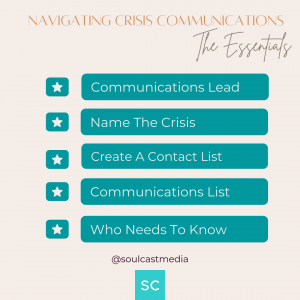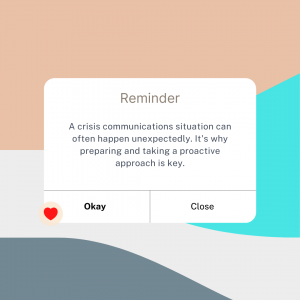Navigating Crisis Communications
Most of the time we cannot anticipate when a crisis will hit. If you ever find yourself in a crisis, you may see that media outlets are now reaching out to you. Your inbox and your phone are all blowing up with requests. And you are juggling everything internally.
It’s a lot!
The good news is, you can prepare for situations like these so you are better equipped to handle them.
When a company faces a crisis situation, developing a solid communications strategy is key. This will help streamline the message, avoid confusion, and help with reputation management.
1. Communications Lead
The best way to begin preparing is to first identify who in the company will be handling the internal and external communications. This means everyone can count on one point person for drafting and disseminating all of the information.
Ideally, this person will either be a communications professional or have a very close relationship with everyone on the management team.
You’ll want to identify who this person will be so when a crisis does hit, they’ll know what to do. They will be able to mobilize very quickly. This person should be able to gather all of the stakeholders together quickly in an emergency meeting.
Once you have your communications lead in place, you will want to all agree and align on the execution and delivery of the message.
Make sure everybody knows the how, what, and when of the message. Nobody ever wants to be surprised.
And even further – ask yourself what the execution of the message requires:
- Will you be going live via one of your social channels?
- Which media outlets will you be speaking to?
It may feel like you are overplanning, even down to which social channel you will use first, but having a rock-solid plan in place will ensure that no one is confused and that the message is disseminated in the right way and in the right order.
2. Name The Crisis
It is important to give a name for a crisis communication situation. For example, you can call the situation cold blue.
Hospitals use the color alert system. This is really effective in getting everyone aligned quickly.
For the communications expert, all they have to do is say code blue, and that will alert the key stakeholders to assemble together.

3. Create A Contact List
A contact list is a one-pager of everyone’s contact information. This list should include the communications spokesperson, C-level executives, and even director levels and above.
Once created, make sure it is disseminated to the key stakeholders so people know how to reach each other if needed.
4. Prepare A List Of Communication Channels
Once a crisis hits, you’ll want to be able to login to your channels. So you will need to prepare a list of communication channels and their login information.
This includes:
- Your company website
- Social media – Facebook, Instagram, and Twitter
 These channels are ways for you to communicate with others. You don’t want to be scrambling at the last minute to find the login information. Oftentimes, in a crisis mode, media outlets will be monitoring a company’s social media sites to see if the company has responded.
These channels are ways for you to communicate with others. You don’t want to be scrambling at the last minute to find the login information. Oftentimes, in a crisis mode, media outlets will be monitoring a company’s social media sites to see if the company has responded.
5. Who Needs To Be Informed
So what do you do when you find yourself in the thick of a crisis communications situation? You need to think about who needs to be informed. In a crisis situation, your internal staff will likely have a lot of questions – and potentially some fear as well.
If they’re not hearing anything, they’ll likely be reading what’s on the news and they’ll have a lot more questions.
You’ll want to make sure you communicate in a short and succinct way to your internal team. You will want to emphasize that you and the management team are aware of what’s happening.
If you don’t have much information right now, be very clear that you will continually update them as the situation unfolds.
This can be through the company website, e-mail or any internal communication channels.
When it comes to responding to external stakeholders, like the media, you’ll want to have monitored the different media sites first to see what they’re saying.
Plan to release a short statement acknowledging the situation at hand. If you don’t have a lot of information, because things are still very fluid, that’s okay. Acknowledging it and saying you’re aware will give the sense that things are being taken care of. Just keep your communications short and succinct.
A crisis communications situation can often happen unexpectedly. It’s why preparing and taking a proactive approach is key.
__
Whenever you’re ready, there are 3 ways we can help you:
- Discover your communications style so you know where to start. Over 4,000 people have found theirs here.
- Attend our monthly communication workshop to build communications confidence (new topics: public speaking, advocating for yourself, building credibility, etc) here.
- Get your brand in front of 43k+ people by sponsoring our newsletter or Soulcast Media | LIVE LinkedIn events [contact: hello@soulcastmedia.com]











